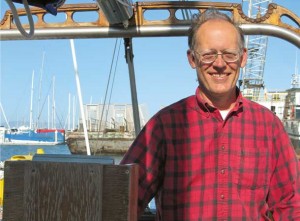There is no happily ever after when it comes to oil spills in the ocean, even when a spill results in stricter regulations or mitigation funds. While wildlife and restoration managers can surely put the funds to good use, no one is likely to claim that such monetary compensation can even the score. Consider the recent allocations from the $16.9 million Luckenbach Fund. Over the course of 50 years, an estimated 50,000 birds were killed by oil seeping from the sunken S.S. Jacob Luckenbach. On a foggy day in 1953, the freighter left San Francisco carrying 457,000 gallons of bunker fuel. After ramming into another ship just 17 miles outside the Golden Gate, it became one of the more than 140 ships that have sunk within the boundaries of the Gulf of the Farallones National Marine Sanctuary, home to a wide variety of marine life and site of one of the nation’s most important seabird nesting areas.
For years, oil slicks and tar balls appeared after heavy storms along the coast north and south of the Golden Gate and caused the deaths of thousands of seabirds, but the source long remained a mystery. One of the biggest events was the 1997-98 Point Reyes Tarball Incident. An unpublished report by Humboldt State University researchers estimated a total mortality in that one season of 18,000 common murres, brown pelicans, and marbled murrelets. Eventually, advances in oil fingerprinting led to more precise finger-pointing, with tests showing that all the mystery oil since 1992 had come from the sunken Luckenbach.
Now, money from the Luckenbach Fund is finally heading toward projects that will help the species that bore the brunt of this slow-motion oil spill. On the Farallon Islands, nearly $1 million will go to eradicate nonnative mice that compete with ashy storm petrels seeking nesting sites. At Point Reyes National Seashore, one project will manage populations of crows and ravens at cattle ranches near common murre nesting sites. Another project will remove European beach grass on dunes where endangered snowy plovers could nest. Researchers have observed that snowy plovers immediately move into cleared test plots to nest or feed their broods. All this is paid for by money that the oil industry puts into a fund created under the Oil Pollution Act of 1990.
In 2002, the Coast Guard spent $19 million to remove what oil it could from the vessel and tried to cap the rest of the leaks. The effort has nearly stemmed the flow, but that doesn’t mean the end of oiled birds. Farallon Program Manager Russell Bradley with PRBO Conservation Science says that he still sees a few oiled birds each year.
“Oil spills remind us of the massive potential impacts these events can have on critical wildlife populations, especially ones that are concentrated like those on the Farallones,” says Bradley. “It also highlights the need for long-term baseline data on populations to help manage spill impacts and assess damages to wildlife.”
The Luckenbach sits 180 feet below sea level. What’s left of the Deepwater Horizon rig in the Gulf of Mexico sits 5,000 feet below the surface. At the time of this writing, even conservative estimates say that every two days the same amount of oil the Luckenbach carried is spewing into the ocean. The extent of the devastation won’t be known for years to come.
If these two spills were fables, we might say there was a moral to the story: oil and water don’t mix. This is real life, and they still don’t.

.jpg)



-300x240.jpg)